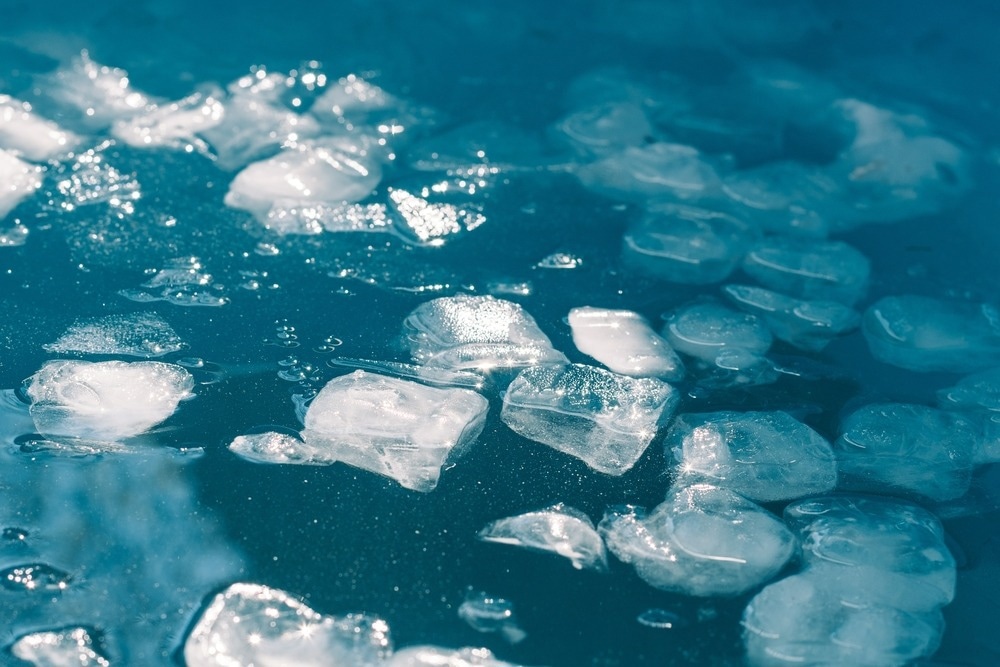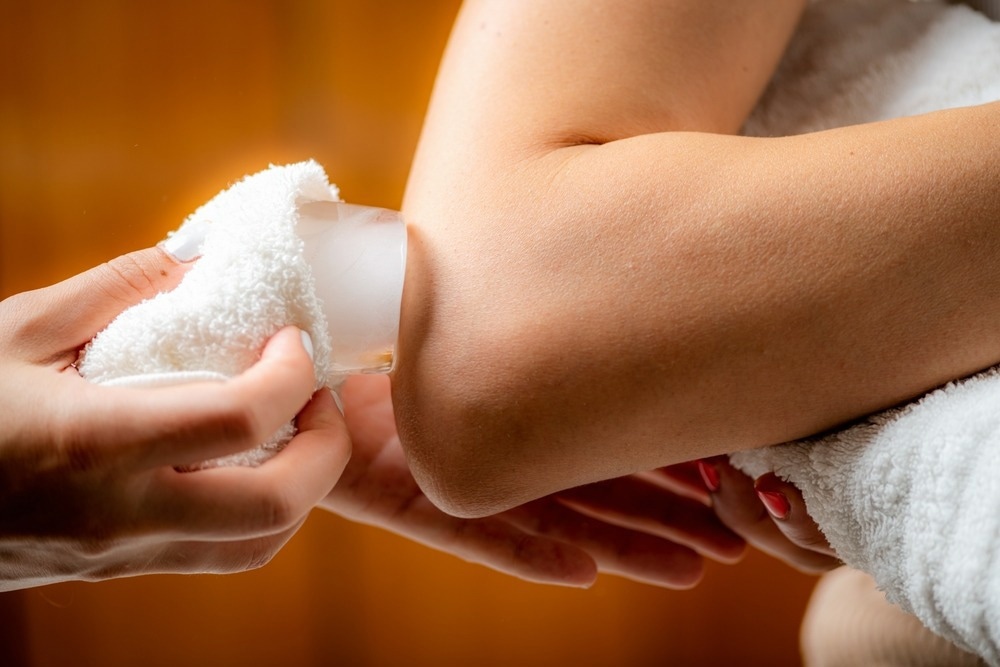Understanding cryotherapy
How cryotherapy works at the cellular and physiological levels
Benefits of cryotherapy
The scientific verdict: What the research says
Risks and precautions
The future of cryotherapy in medical practice
References
Further reading
Cold has been used to treat illnesses since at least 450 BC when Hippocrates advised packing wounded soldiers in ice to delay death. In the 1800s, wounded soldiers were cooled to promote recovery by reducing pain and bleeding.

Image Credit: Michele Ursi/Shutterstock.com
Later, people realized that cold-water drowning victims appeared to escape the effects of prolonged asphyxia. Therapeutic hypothermia was then used in various surgical procedures to avert hypoxia-related injury. This led to the current revival of interest in cryotherapy.
Understanding cryotherapy
Cryotherapy is defined as the superficial application of cold to the body for therapeutic purposes. It leads to reduced core and tissue temperatures.
Cryotherapy may be local or systemic. Local cryotherapy (LC) employs ice compresses or ice massages as well as phase-change materials (PCM) and cryo-compression devices. Systemic cryotherapy may use immersion in cold and icy water (cold-water immersion, CWI) and convective cryotherapy, either whole-body or partial-body cryotherapy (WBC or PBC, respectively).
Both WBC and PBC involve standing fully within, or with the head and neck outside, respectively, a very cold chamber cooled by liquid nitrogen or cold air for 2-4 minutes, with minimal clothing.
How cryotherapy works at the cellular and physiological levels
Cryotherapy is linked to pain relief and functional improvement. The primary mechanism is by reducing sensory nerve transmission at the site, while the peripheral vasoconstriction slows down the metabolic rate in the tissues involved. By reducing oxidative stress, it reduces secondary ischemic injury and alleviates inflammation.
Cold-induced parasympathetic activation enhances long-term muscle recovery and improves sleep quality. Cryotherapy after strenuous exercise also relieves exercise-induced hyperthermia, thus reducing brain-mediated fatigue and cardiovascular strain.
Finally, PBC attracts more lymphocytes into the bloodstream and the injured tissues, promoting cell repair. Though often quoted, there is no evidence for a wash-out of inflammatory chemicals by vasodilation.
Benefits of cryotherapy
Cryotherapy proponents claim that “the repeated shock-like cryogenic cold stimulus over the entire body surface induces reactions in the autonomic, endocrine, circulatory, neuromuscular and immunological systems, resulting in an adaptation that contributes to the restoration of the homeostatic state.”
Below are some of the potential benefits of cryotherapy:
- Cryotherapy is claimed to accelerate recovery in painful chronic inflammatory and degenerative conditions such as rheumatoid arthritis (RA) and osteoarthritis, as well as acute post-exercise or post-injury muscle soreness and joint pain.
- Cryotherapy is said to reduce acne and detoxify skin cells, regenerate skin and eliminate dead skin, enhance collagen production and reduce wrinkles, burn away cellulite deposits, combat inflammation, and thus help control conditions like eczema and psoriasis, and delay skin aging.
- WBC is promoted as able to boost whole-day metabolism, shifting the fat-associated endocrine profile favorably and increasing caloric expenditure while reducing inflammation, thus fighting obesity.
- WBC is said to improve sleep as well as elevate the mood in anxiety and depression by triggering the release of endorphins and catecholamine hormones.
The scientific verdict: What the research says
Analyzing key studies on cryotherapy
A review of studies between 2000 and 2023 shows much promise for cryotherapy in pain relief. WBC is effective in inflammatory conditions like RA (80% of Dr. Yamaguchi’s RA patients found full relief). LC or WBC/PBC are both useful in degenerative painful conditions like osteoarthritis.
Cryotherapy significantly improves post-exercise muscle soreness and fatigue and speeds up muscle recovery compared to other methods, including contrast or warm-water therapy, especially for endurance or intermittent training.
Some evidence suggests that WBC promotes persistent symptom relief and skin healing in atopic dermatitis.

Image Credit: Microgen/Shutterstock.com
Cryotherapy appears to increase total antioxidant activity and normalize inflammatory markers, making it a potential adjunct in weight loss therapy.
Small studies suggest potential benefits from WBC “as a short-term adjuvant therapy for depressive and anxious patients.”
There is little evidence beyond anecdotes for the use of cryotherapy as a cosmetic treatment, though it may ease the redness, bleeding, and pain associated with skin-ablative procedures.
Risks and precautions
With millions of cryotherapy sessions occurring worldwide each year, very few serious adverse reactions have been reported. Potential risks include frostbite, panniculitis after prolonged exposure, cold urticaria, bradycardia, nerve injuries, and transient reduction in muscle function due to the cooling. For properly screened patients, cryotherapy is likely to be safe with few and mild adverse effects.
With WBC, hypoxia, and suffocation may potentially occur due to the partial replacement of oxygen by nitrogen for cooling.
Cryotherapy patients must be screened for conditions like cryoglobulinemia and peripheral vascular conditions, including Raynaud’s disease, to avoid thrombotic events. Pregnancy, cardiovascular risk factors, nerve damage and cold allergy, and peripheral numbness or open injuries contraindicate cryotherapy.
A rest period is mandatory to allow muscle and nerve function to recover before active or complex exercise.
Most cryotherapy centers being unregulated, protocols must be in place to ensure targeted physiological changes occur, detecting hypothermia and preventing prolonged cold exposure. Qualified attendance is mandatory for WBC/PBC, as well as hand/foot protection and active finger/toe movement.
The future of cryotherapy in medical practice
Newer cryotherapy devices in use include cryo-compression devices to cool and compress injured areas for long periods, providing pain relief. These were first used after major joint surgery like knee replacement or spine surgery. They may not help restore muscle strength.
These use PCMs that change phase at specified temperatures with large latent heat. They may speed up muscle strength recovery and relieve soreness.
Future research should examine the use of various cryotherapy methods and media based on relative heat transfer and cooling efficiencies, as well as the area exposed, duration of cooling, and timing after acute injury.
Other applications of cryotherapy remain experimental at present. Large, well-designed trials are essential in this area.
While the place of cryotherapy in post-exercise soreness and muscle recovery seems evidence-based, “Long-term effects, a standardized approach, and careful study of other chronic pain syndromes should be considered in future research to further support the use of cryotherapy in the management of chronic pain.”
Supervised cryotherapy may help selected patients with chronic musculoskeletal pain, obesity, or mood disorders as an adjunct to lifestyle modifications, moderate regular exercise, stress relief, and social support networks.
References
- Bleakley, C. et al. (2023). Cold‐water immersion (cryotherapy) for preventing and treating muscle soreness after exercise. Cochrane Database Systematic Reviews. doi: https://doi.org/10.1002%2F14651858.CD008262.pub2. https://www.ncbi.nlm.nih.gov/pmc/articles/PMC6492480/.
- Garcia, C. et al. (2020). Use of cryotherapy for managing chronic pain: an evidence-based narrative. Pain and Therapy. doi: https://doi.org/10.1007/s40122-020-00225-w. https://link.springer.com/article/10.1007/s40122-020-00225-w.
- Capodaglio, P. et al. (2022). Whole-body cryostimulation: a rehabilitation booster. Journal of Rehabilitation Medicine – Clinical Communications. doi: https://doi.org/10.2340%2Fjrmcc.v5.2810. https://www.ncbi.nlm.nih.gov/pmc/articles/PMC9495643/.
- Klimenko, T. et al. (2008). Whole-body cryotherapy in atopic dermatitis. Archives of Dermatology. doi:10.1001/archderm.144.6.806. https://jamanetwork.com/journals/jamadermatology/fullarticle/419737.
- Ferreira-Junior, J. B. et al. (2014). Could whole-body cryotherapy (below −100°C) improve muscle recovery from muscle damage? Frontiers in Physiology. doi: https://doi.org/10.3389/fphys.2014.00247. https://www.frontiersin.org/articles/10.3389/fphys.2014.00247/full.
- Allan, R. et al. (2022). Cold for centuries: a brief history of cryotherapies to improve health, injury and post-exercise recovery. European Journal of Applied Physiology. doi: https://doi.org/10.1007/s00421-022-04915-5. https://link.springer.com/article/10.1007/s00421-022-04915-5.
- Chaoyi, Q. et al. (2022). Cryotherapy on subjective sleep quality, muscle, and inflammatory response in Chinese middle- and long-distance runners after muscle damage. Journal of Strength and Conditioning Research. doi: 10.1519/JSC.0000000000003946. https://journals.lww.com/nsca-jscr/abstract/2022/10000/cryotherapy_on_subjective_sleep_quality,_muscle,.27.aspx.
- Cryotherapy (2023). https://my.clevelandclinic.org/health/treatments/21099-cryotherapy.
- Whole body cryotherapy can be hazardous to your skin (2023). https://www.aad.org/public/cosmetic/safety/cryotherapy.
- Kwiecien, S. T. et al. (2019). Prolonged cooling with phase change material enhances recovery and does not affect the subsequent repeated bout effect following exercise. European Journal of Applied Physiology. doi: https://doi.org/10.1007/s00421-019-04285-5. https://link.springer.com/article/10.1007/s00421-019-04285-5.
- Douzi, W. et al. (2018). 3-min whole body cryotherapy/cryostimulation after training in the evening improves sleep quality in physically active men. European Journal of Sports Science. doi: 10.1080/17461391.2018.1551937. https://pubmed.ncbi.nlm.nih.gov/30551730/.
- Wilson, L. J. (2018). Whole body cryotherapy, cold water immersion, or a placebo following resistance exercise: a case of mind over matter? European Journal of Applied Physiology. doi: https://doi.org/10.1007/s00421-018-4008-7. https://link.springer.com/article/10.1007/s00421-018-4008-7.
- Ihsan, M. et al. (2016). What are the physiological mechanisms for post-exercise cold water immersion in the recovery from prolonged endurance and intermittent exercise? Sports Medicine. doi: https://doi.org/10.1007/s40279-016-0483-3. https://link.springer.com/article/10.1007/s40279-016-0483-3.
- Dzidek, A. et al. (2022). The use of cryotherapy in cosmetology and the influence of cryogenic temperatures on selected skin parameters—a review of the literature. Cosmetics. doi: https://doi.org/10.3390/cosmetics9050100. https://www.mdpi.com/2079-9284/9/5/100.
- Rose, C. L. et al. (2022). Partial body cryotherapy exposure drives acute redistribution of circulating lymphocytes: preliminary findings. European Journal of Applied Physiology. doi: https://doi.org/10.1007/s00421-022-05058-3. https://link.springer.com/article/10.1007/s00421-022-05058-3.
- Rymaszewska, J. et al. (2008). Whole-body cryotherapy as adjunct treatment of depressive and anxiety disorders. Archivum Immunologiae et Therapiae Experimentalis. doi: https://doi.org/10.1007/s00005-008-0006-5. https://link.springer.com/article/10.1007/s00005-008-0006-5.
- Legrand, F. D. et al. (2023). Evaluating safety risks of whole-body cryotherapy/cryostimulation (WBC): a scoping review from an international consortium. European Journal of Medical Research. doi: https://doi.org/10.1186/s40001-023-01385-z. https://eurjmedres.biomedcentral.com/articles/10.1186/s40001-023-01385-z.
- Falla, M. et al. (2021). The effect of cold exposure on cognitive performance in healthy adults: a systematic review. International Journal of Environmental Research and Public Health. doi: https://doi.org/10.3390/ijerph18189725. https://www.mdpi.com/1660-4601/18/18/9725.
[Futher reading: Hypoxia]